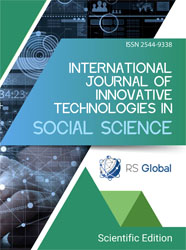DATING LIME MORTAR BY OSL METHOD, WEST CHERCHELL THERMAL BATHS: A CASE STUDY
Abstract
The city of Cherchell is known as an ancient city, civilizations have succeeded in the latter from the Phoenicians to the Turkish period. The western thermal baths of this city are little known, Stéphane Gsell attributes their construction to the end of the 2nd beginning of the 3rd century [1] unlike Pensabene [2] which indicates that these dates are not based on any reliable argument, it adds to this problem dating the initial construction, the problem of remodeling during its use or the current plan seems to be symmetrical like the thermal baths of Rome or certain thermal baths in North Africa such as Carthage, Timgad [3]. So in this case an absolute dating is required, the dating of the Arian lime mortar mixed with the quartz sand used for the construction by the OSL dating method used by myself (Bouzetine and all 2021)[4] offers a great possibility of resolving these problems on all that it gives very reliable results.
To do this we took samples of lime mortars MC01 from the southern part assumed to be symmetrical to the northern part, MC02 the part assumed to be added later on the west side and mortar MC03 for the assumed initial part.
A characterization by SEM-EDX and chemical analysis by fluorescence dates from the late 2nd early 3rd century and the western part was built a little later, the shape of the baths was almost certainly symmetrical.
References
S. GselI, (1901), «Les Monuments antiques de l'Algérie» ,Tome premier paris ,p 212 ;
P. Pensabene, (1982), « Les chapiteaux de Cherchel», 3e sup. au BAA, , p. 9 et 19, chapiteaux nos 15 et 16
F.Yegul, (1942), «Baths and Bathing in classical antiquity, the architectural history foundation», new York, p195 and p 201
K. Bouzetine, M. Hamiane, P. Guibert,(2021), « Osl Dating Of Terracotta Bricks Of The Old Mosque Of Mila, Algeria: A Case Study», International Journal of Conservation Science,
H. Marchand.(1932), « Cherchell préhistorique», In: Bulletin de la Société préhistorique de France, tome 29, n°10,. pp. 474 doi : https://doi.org/10.3406/bspf.1932.5652
Ph. Leveau, «Caesarea Mauretaniae », open édition journal. p. 1698-1706 doi.org/10.4000/encyclopedieberbere.1899
Ph. Leveau, « Caesarea Mauretaniae », p. 1698-1706 https://doi.org/10.4000/encyclopedieberbere.1899
Source google earth,vue le 15 Juin 2024
S. Gsell, Ml Leglay (1952), « Cherchel Antique Iol-Caesarea », Edité par Direction de l'Intérieur et des Beaux-Arts Service des Antiquités,
P. Guibert., «La luminescence Un bref éclairage sur une méthode de datation pour l’archéologie», Reflets de la Physique n° 63, p9 https://doi.org/10.1051/refdp/201963008
J. Götze , (May 2001), « Cathodoluminescence (CL) of quartz: origin, spectral characteristics and practical applications. Mineral Petrol, DOI: 10.1007/s007100170040
M. Duttine.(2005), « Recherche de provenance de quartz et d’obsidiennes préhistoriques en Europe occidentale : apports de la résonance paramagnétique électronique (RPE)», Thèse de doctorat.,Université Michel de Montaigne.
Petra Urbanová. (2015),«Recherches sur la datation directe de la construction des édifices : exploration des potentialités de la datation des mortiers archéologiques par luminescence optiquement stimulée (OSL) ». Archéologie et Préhistoire. Université Michel de Montaigne - Bordeaux III,
S. Blain, P. Guibert, A. Bouvier, E. Vieillevigne, F. Bechtel, C. Sapin, M. Baylé,(2007). «TL-dating applied to building archaeology: The case of the medieval church Notre-Dame-sous-Terre (Mont-Saint-Michel, France) », Radiation Measurements, 42, 2007, pp. 1483-1491.
I.K. Bailiff, N. Holland,(2000), « Dating bricks of the two last millennia from Newcastle upon Tyne: a preliminary study », Radiation Measurements, 32, , pp. 615- 619.
I.K. Bailiff, (2007), « Methodological developments in the luminescence dating of brick from English late-medieval and post-medieval buildings», Archaeometry 49, Article Number: 827et 851. http://dx.doi.org/10.1111/j.1475-754.2007.00338.x.
A.S. Murray, A.G. Wintle,(2000), « Luminescence dating of quartz using an improved single-aliquot regenerative dose protocol», Radiation Measurements, 32, , pp. 523–538.
A.G. Wintle, A.S. Murray,(2006), « A review of quartz optically stimulated luminescence characteristics and their relevance in single-aliquot regeneration dating protocols», Radiation Measurements 41(4), pp 369–391
S.W.S. McKeever, R. Chen,(1997), « Luminescence models», Radiation Measurements, 27(5-6), pp. 625-661.
M.J. Aitken, (1985), « Thermoluminescence Dating », Academic Press, London, , p. 359.
P. Guibert, C. Lahaye, F. Bechtel,(2009), « The importance of U-series disequilibrium of sediments in luminescence dating: a case study at the Roc de Marsal cave (Dordogne, France) », Radiation Measurements, 44, , pp. 223-231.
F. De Corte, D. Vandenberghe, J.-P. Buylaert, P. Van den Haute, J. Kučera,(2006), « Relative and k0-standardized INAA to assess the internal (Th, U) radiation dose rate in the ‘‘quartz coarse-grain protocol’’ for OSL dating of sediments: Unexpected observations», Nuclear Instruments and Methods in Physics Research A 564, pp. 743–751.
D. Vandenberghe, F. De Corte, J.-P. Buylaert, J. Kučera, P. Van den Haute,(2008), « On the internal radioactivity in quartz», Radiation Measurements, 43, , pp. 771 – 775.
P. Guibert, I.K. Bailiff, S. Blain, A.M. Gueli, M. Martini, E. Sibilia, G. Stella, S.O. Troja,( 2009), «Luminescence dating of architectural ceramics from an early medieval abbey: The St-Philbert intercomparison (Loire-Atlantique, France) », Radiation Measurements, 44(5-6), , pp. 488-493.
P. Urbanová, A. Michel, N. Cantin, P. Guibert, P. Lanos, P. Dufresne, L. Garnier,( 2018), «A novel interdisciplinary approach for building archaeology: The integration of mortar “single grain” luminescence dating into archaeological research, the example of Saint Seurin Basilica, Bordeaux», Journal of Archaeological Science: Reports, 20, , pp. 307-323.
G. Guérin, N. Mercier, G. Adamiec,(2011), « Dose-rate conversion factors: Update», Ancient TL, 29, , pp. 5-8.
Views:
70
Downloads:
42
Copyright (c) 2025 Kamel Bouzetine, Mourad Belaidi, Zoulikha Tikarrouchine

This work is licensed under a Creative Commons Attribution 4.0 International License.
All articles are published in open-access and licensed under a Creative Commons Attribution 4.0 International License (CC BY 4.0). Hence, authors retain copyright to the content of the articles.
CC BY 4.0 License allows content to be copied, adapted, displayed, distributed, re-published or otherwise re-used for any purpose including for adaptation and commercial use provided the content is attributed.











